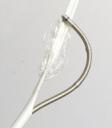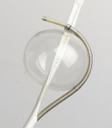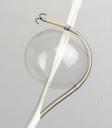Lombard Medical Technologies, a London-based company that makes cardiovascular devices and polymer coatings, has received two regulatory approvals that move the  company’s stent graft fixation product closer to launch.
company’s stent graft fixation product closer to launch.
The approvals — a CE Mark and conditional IDE — are for EndoRefix, a device that provides fixation of endovascular stent grafts that treat abdominal aortic aneurysms. In certain anatomies, stent grafts have a tendency to migrate, which can cause endoleaks. EndoRefix delivers percutaneously tiny fasteners (staples), which are pushed through both the walls of the stent graft and aorta to keep the graft in place.
The CE Mark is for the reconfiguration of EndoRefix, to incorporate a new coating to the clip cartridge catheter, which improves the controllability and performance.
 The conditional IDE approval allows Lombard to begin patient treatment enrollment at investigational centers that have obtained their IRB approval of the protocol for the pivotal U.S. trial. The conditions of approval require clarifications to the statistical analysis of study end points and a completed statistical analysis plan for product claims. While providing these clarifications, Lombard will continue development of the manufacturing process with the goal of beginning recruitment in early 2008.
The conditional IDE approval allows Lombard to begin patient treatment enrollment at investigational centers that have obtained their IRB approval of the protocol for the pivotal U.S. trial. The conditions of approval require clarifications to the statistical analysis of study end points and a completed statistical analysis plan for product claims. While providing these clarifications, Lombard will continue development of the manufacturing process with the goal of beginning recruitment in early 2008.
Lombard, a seven-year-old company that trades on the London Stock Exchange, has already established a distribution partnership with Medtronic for EndoFix. Under the brand name Securant, Medtronic will launch the product in Europe and in the U.S.
 A limited European launch will follow the successful conclusion of a small, 10-patient clinical study, to be undertaken later this year, to evaluate the clinical utility of EndoRefix as an adjunctive procedure to endovascular abdominal aortic aneurysms stent graft therapy. Medtronic plans to widen the European launch as further clinical experience of the product is gained throughout 2008.
A limited European launch will follow the successful conclusion of a small, 10-patient clinical study, to be undertaken later this year, to evaluate the clinical utility of EndoRefix as an adjunctive procedure to endovascular abdominal aortic aneurysms stent graft therapy. Medtronic plans to widen the European launch as further clinical experience of the product is gained throughout 2008.
Lombard says its technology for the repair of abdominal aortic aneurysms addresses a $400 million worldwide market that’s expected to rise to $1 billion by 2010.